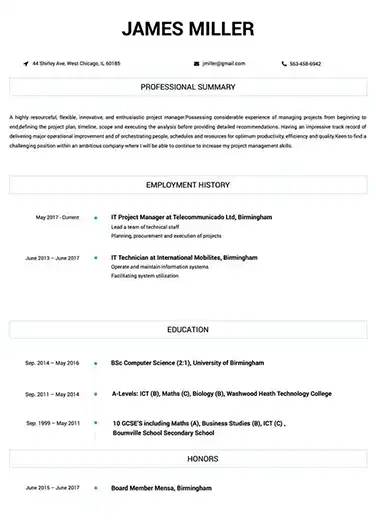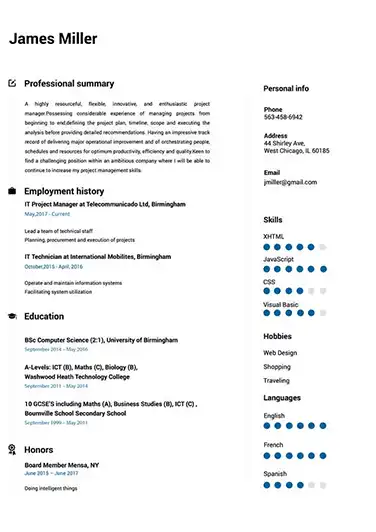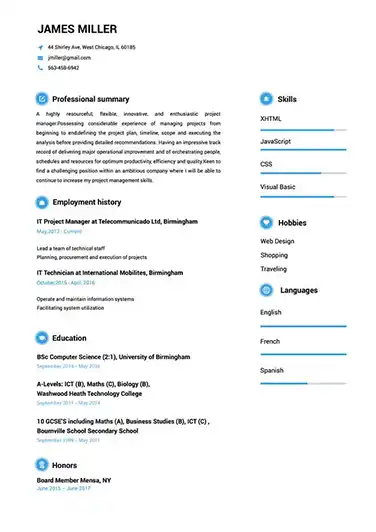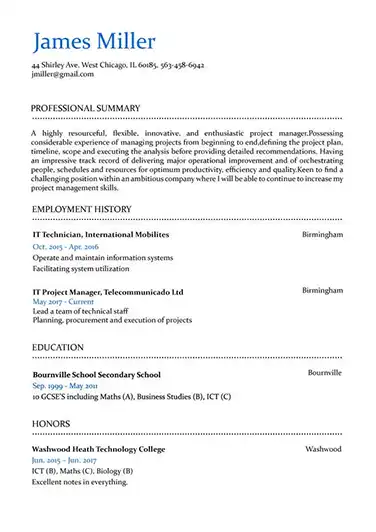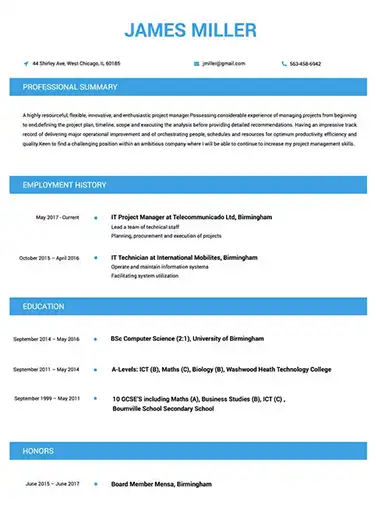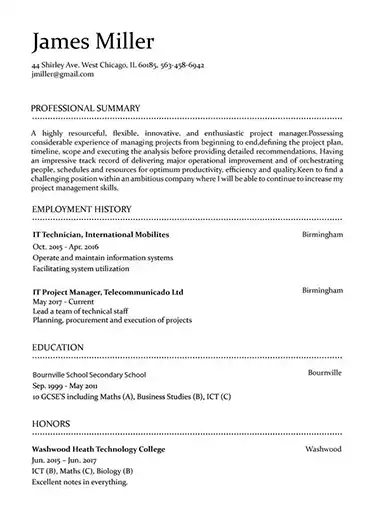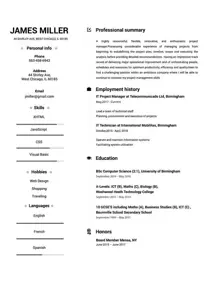 Use This Template
Use This Template
Build your resume in 15 minutes
Create an awesome resume that meets the expectations of potential employers with our selection of professional, field-tested resume templates.
ux/ui designer: Resume Samples & Writing Guide
Despite their differences, the best approach to creating a UX designer resume and a UI developer resume are extremely similar. That’s why this guide will walk you through both.
Ultimately, your resume is a communication tool. It’s designed to efficiently convey information to a reader. So think about your resume as a UX challenge. If the reader (IE the user) has a good experience and can easily get the information they need from your resume, you’re far more likely to get the job. As a nice side bonus, you’ll be demonstrating your job skills through your resume.
But what do you actually need to do to create an effective UX or UI designer resume? Let’s go through all the sections we’ll cover.
What you’ll learn in this guide
- How to use resume examples to get started
- What you can do to get your resume noticed
- How to ensure your resume makes it past ATS
- What recruiters will look for in your resume
- How to properly format your resume
- What to include in your education section
- Why certifications are worth considering
- How to choose which skills to include
- How to highlight your achievements
- Why starting with an objective or summary makes all the difference
- What to do if you have little or no UX / UI experience
- How to use a resume builder to make the process easier
UX / UI Designer Resume Template Examples
If you’re starting off on a UX or UI design project, one of your first steps is to check out what’s been done on similar platforms or products. This is often the fastest way to learn not just what you might want to do but what you definitely don’t want to do.
The same approach works for resumes, so we’ve compiled a list of some of our favorite UX and UI designer resumes to give you an idea of what you should be aiming for. Look through them and take notes about which elements you do and don’t want to incorporate into your own resume.
[Examples]
How to write a UX / UI designer resume that will get you noticed by recruiters
If you turn in a resume which seems 100% focused on letting you talk about what a great UX or UI designer you are but makes the recruiter’s job harder, you’re not getting hired. Why? Because you just showed you don’t understand the basics of the role you want. Your resume needs to be thoughtful, mistake-free, and impeccably designed.
But as with any UX or UI project, getting your resume just right starts with understanding its audience.
The two key audiences you need to understand
In most cases, your resume needs to appeal to two specific audiences in order for you to get hired. You should be considering these audiences at every step of the process from pre-planning to final review. So let’s go over both of those audiences together and understand how to appeal to them.
How to prepare your resume for ATS
The greatest irony of the way most of us apply for jobs today is that we assume a person will be reviewing our resume when that’s often not the case. That’s because Applicant Tracking Systems (ATS) have become a standard hiring tool for most companies. These AI-driven algorithms analyze resumes at scale, allowing companies to reduce the number of recruiters they need to review them.
The problem is that these systems are far from perfect. As many as 75% of qualified resumes are rejected by ATS because of formatting issues or other errors. That’s bad news if you don’t know how to get past ATS. But it’s great news for you, because you’ll be in that 25% with less competition. So what do you need to do to ensure your resume makes the cut?
- Submit your resume in an accepted file format. This is the easiest one to get right, .doc, .docx, and .pdf all work. Other formats like images don’t work for ATS.
- Use a resume builder to ensure your file is ATS-friendly. Just because ATS are designed to work with a small number of file formats doesn’t mean they can read everything equally well. The way the information is structured within the file has an enormous impact on the ability of ATS to properly read it. That’s why you want to use a resume builder which has been designed to generate ATS-readable files.
- Be strategic about your keyword usage. The basic way ATS work is that they are given a set of skills and experience to look for in resumes. They’re generally pretty intelligent, but far from perfect, so your best move is to make it as obvious as possible that you meet the criteria the ATS has. The way to do this is to start with the job ad and use it to create a list of the skills and experience you think it’s asking for. Then, put these on your resume as much as possible, mimicking the exact language used in the job ad to ensure there’s no confusion.
Getting into the heads of recruiters
Once your resume gets past ATS, it still needs to impress a human recruiter. This is where your experience thinking deeply about customer experiences comes into play. Think about that recruiter, what are their needs, desires, challenges, etc. and how can your resume address as many as possible?
For example, at the very least the information in your resume needs to be structured so a recruiter can easily gather the most important bits first (more on that in the next section). The resume should also have modern design so it’s pleasant to look at. But overall, your resume should make saying “yes” to you as a candidate easy. The keyword work you did to get past ATS should also help make your resume more effective in this regard.
How to format your resume
You already know that formatting is about much more than putting the right sections in the right place. It’s about structuring information so the user has a pleasant experience. Using that principle to guide you, start by ensuring the most important information in your resume at the top. Ideally, after reading a resume objective or summary (more details on those later) at the top of your resume recruiter will know the core argument as to why you’re the best candidate for the job.
At that point, reading the rest of your resume is simply filling in the gaps. But beyond that basic rule, your resume should put its information in reverse chronological order. That means your most recent work experience goes at the top because it’s the most relevant.
How long should a UX / UI resume be?
The most common formatting question everyone has is about the proper length for their resume. Again, here you should be using your UX and UI intuition to guide you. How many pages do you need to get across the most critical information? What’s the point at which adding more to your resume gets you diminishing returns? While in general more junior UX or UI designer resumes should be a single page and more senior ones up to 2, the impact of adding more information on the recruiter’s experience should be your ultimate guide.
What should UX / UI designers put on a resume?
While adding all of these sections would be overkill, these are the main sections you should consider adding to your resume.
- Resume objective or summary
- Work experience
- Certifications
- Achievements
- Projects
- Education
- Hard skills
- Soft Skills
How to list your education on a resume
A common resume mistake even UX or UI designers make it throwing in information that doesn’t really add any value. Your education section is a prime example. If your degree isn’t directly related to UX or UI, you can probably leave it off unless you obtained it fairly recently. Otherwise, only include details about your education if they’re relevant to the job you’re applying to.
A recruiter doesn’t care what GPA you got at university 10 years ago or that you played basketball. The exception would be, for example, you saw on social media that the team members you’ll be working with like to play basketball. In this case, while it’s not related to your work, it helps to show that you’d fit in well with the team.
Here are two examples to illustrate the difference.
BA in English
The University of Massachusetts Amherst
2009-2013
-Thesis was on English identity in The Canterbury Tales
-Had an overall GPA of 3.7
None of that information really tells a recruiter anything useful about you as a UX or UI designer.
BA in Digital Design and Development
Howest University
2012-2016
In this case, the degree is related to the job you’re applying for but it’s far enough in the past that it’s not worth going into details about your studies. If the recruiter is interested, they’ll ask you about it in the interview.
How to list certifications
The challenge with the education section of a UX or UI designer is that there aren’t many degrees in the field. That’s why certifications and other training are extra important. They’re a faster, cheaper, and more up-to-date way to demonstrate your abilities in a short and concrete way. This is because in just a few letters next to your name, you can communicate a whole set of skills instead of having to spell them out manually. This is particularly important if you don’t have much work experience.
In other words, they add a lot to your resume so you should consider obtaining one. Here are some top ones you should consider.
The best UX / UI designer certifications to include
- UX Design Institute Professional Diploma
- UiPath Certified Professional
- Interaction Design Foundation UX design course
- The Nielsen Norman Group UX certification
- The CareerFoundry UX Design Program
- The Springboard UX Career Track
How to choose the right UX / UI designer skills to include
As mentioned above, the key here is to include skills which match the job description. That doesn’t mean list skills you don’t have (lying on your resume is just never a good idea), but going as far as you can to ensure your resume works as a kind of answer to the question of the job ad.
The most effective way to list your skills is (when possible) with concrete examples. This is because while it’s important to list the right skills for ATS, simply stating that you have great attention to detail won’t necessarily leave much of an impression on a recruiter. Including an example will make your skills seem more concrete.
Experienced in using Adobe Suite Software
This sounds fine, but adding something more specific will make this experience more impactful.
Experienced in using the Adobe Software Suite
-Adobe Digital Learning Certifications in Ps, Id, and Xd
Mentioning those certifications means a recruiter doesn’t have to wonder whether you have experience in a specific Adobe product or whether you’re exaggerating your abilities.
Which hard skills should you mention on your resume?
- Adobe Suite
- Sketch
- Javascript
- HTML
- CSS
- Copywriting
- Wireframes
- Invision
- GitHub
- Command Line
- Responsive Design
- UI Prototyping
Which soft skills should you mention on your resume?
- Attention to detail
- Working well under pressure
- Time management
- Creativity
- Presentation skills
- Working well on a team
- Customer service
- Creative problem solving
How to highlight your most important achievements
Another common mistake UX and UI designers make on their resumes is to focus too much on their responsibilities in their past jobs. The way to make your experience really stand out to a recruiter is to focus on your achievements. These could be listed under your job experience, or if they’re from outside your formal work history in their own section.
Responsible for UX design at Interia Systems.
For all we know you could have been fired for incompetence and this sentence would still be 100% true. That’s the problem with listing responsibilities, they don’t really tell the reader anything of value.
Obtained a 92% customer satisfaction score and successfully met 22/23 major project deadlines while working as a UX designer at Interia Systems.
This example gives a few specific metrics to measure success at the specific position and reads completely differently as a result. Besides making the candidate sound competent, they also give the impression that this person pays attention to details.
What are the differences between resume objective and summary? Where do I use which?
AS mentioned earlier in this guide, the best way to start your resume is with an objective or summary at the top. This is because these short sections allow you to be flexible and focus the recruiter’s attention on the key details which make you look best as a candidate. They’re also a great way to bring up information that doesn’t fit easily into any other sections of your resume.
But what’s the difference between the two? In short, a resume objective is shorter and more focused on what you aim to achieve with your resume. It’s an ideal choice if you are also including a cover letter or if there’s no need to go into longer details early on in your resume.
On the other hand, if there’s something important that you need to explain in more than a sentence right at the start (like a gap in your work history or a career change) a resume summary is the way to go. These can be up to a few sentences but should still be as concise as possible.
How to write a resume objective
The main goal of a resume objective is to fit as much quality information as possible into a very small space while still being readable. Let’s look at two examples to understand this in practice.
I’m a talented UI professional with the experience needed to excel in this position.
This resume objective fails to tell the recruiter a single useful thing. It might get across that you’re self confident, but that’s about it. If a recruiter reads this they will think that you’re full of hot air and prone to wasting time. It does not make a good first impression.
UiPath Certified Professional with 5 years experience in Sony’s Smart TV division looking to bring consumer electronics experience to improve Philips’ kitchen appliance UI.
This example is getting long for an objective, but it makes up for that by being packed with useful information. It tells a recruiter that you’re certified, what kind of experience you have, how you’re looking to apply that experience in this new role, and that you’ve tailored your resume for the position. In other words, it makes a strong first impression and provides valuable context for the rest of the resume.
How to write a resume summary
A resume summary follows the same rules as an objective, but gives you more space to go into details. Let's see two examples to understand what you should and should not do in this section.
After working for several years in product development I realized that my true passion was in UX design. After taking a few years off to obtain a degree in UX I’m not looking to start off my career with a position at your company. I may not have that much experience but I’m highly motivated and eager to start.
There’s a lot wrong with this example. It’s written in the first person, but more than that it’s far too informal. It makes the writer sound like a student or an intern and not like a competent professional. It’s light on details but wordy enough to take up a large amount of valuable real estate at the top of the resume. Now let’s look at a better version.
Former product development professional looking to transition into UX after obtaining a UX degree. In the process of obtaining a Nielsen Norman Group UX certification and looking to further expand UX experience and skill set at Pioneer Consumer Technologies.
This example focuses on explaining why the candidate has switched over to UX from product development and shows that they’re working hard to improve their skills in that area. It tells a recruiter that they may not have as much experience as another candidate but they certainly have the right attitude and mindset for success. This would have been hard to communicate elsewhere on a resume, so explaining it in a summary is effective.
How to write a UX / UI designer resume with little to no experience
The single key thing to remember if you don’t have much experience as a UX or UI designer is that attitude and mindset are often more valuable than experience. You can hire the best UX designer in the world but if they’re a nightmare to work with, they’re not worth much. Companies can help you develop skills, but teaching you to be diligent, creative, and work well in teams is much harder.
That’s why the best approach on a resume with less experience is to emphasize these kinds of soft skills (preferably with examples). For your hard skills, list as many as you can and then try to obtain a relevant certification. Even if you haven’t completed it by the time you’re applying for jobs, you can mention that you’re in the process (like in the resume summary example above). Again this shows that you’re dedicated enough to get certified even if you don’t have a ton of experience, which can set you apart from other candidates.
How to make your resume stand out
If you’ve made it this far in our guide you’ve already seen tons of suggestions for how to make your resume stand out. The best thing you can do is ensure your resume is well-written and targeted both to the specific job and to the recruiter reading it. A resume that takes those two things into consideration will stand out.
But beyond the content, your resume can and should utilize great design to stand out. In a sea of Word documents, a resume which uses clean and modern design to better convey its information will always stand out. To get a resume like that which can be easily read by ATS you need a resume builder.
Why a resume builder is an essential tool
This guide should make it clear that there’s a lot of small elements you need to get right on your resume. Add in the importance of tailoring you resume to each position and it will take a lot of time to find the right job. That’s why using a time-saving tool like a resume builder makes sense.
These builders are specifically designed to make it easy to produce modern ATS-friendly resumes so you don’t have to focus too much on those details. The interface also makes it simply to copy, edit, and customize many versions of a resume, saving you time when applying for many jobs. If you’d like to see why resume builders are fast becoming the new standard way to find a great job, check out Resumebuild.com’s powerful builder tool.
ux/ui designer Job Descriptions; Explained
If you're applying for an ux/ui designer position, it's important to tailor your resume to the specific job requirements in order to differentiate yourself from other candidates. Including accurate and relevant information that directly aligns with the job description can greatly increase your chances of securing an interview with potential employers.
When crafting your resume, be sure to use action verbs and a clear, concise format to highlight your relevant skills and experience. Remember, the job description is your first opportunity to make an impression on recruiters, so pay close attention to the details and make sure you're presenting yourself in the best possible light.
ux/ui designer
- Gathering and evaluating user requirements, in collaboration with Product managers and Engineers.
- Work alongside Business Analysts to ensure that business requirements are met.
- Illustrating experience design ideas using storyboards, process flows and sitemaps.
- Conceptualisation of user interface elements using low and high fidelity wireframes.
- Develop UI mock-ups and prototypes that clearly illustrate the user journey and how sites function and look like.
- Heuristic evaluation of existing channels, to identify specific UX problems (e.g. responsiveness).
- Adjustment of designs based on user testing feedback.
ux/ui designer
- Close collaboration with the Online brand manager, Channel manager and Portal development teams.
- User journey mapping and creation of wireframes to bring concepts to live.
- Visual design for sections of company portals, including the development of a content portal in which video and imagery can be stored.
- Visual upkeep of portals, as aligned to collaboration between the Marketing and Brand teams.
- Collaboration with HR to maintain the internal portal (Intranet).
- Working on the internal CMS to ensure an enhanced experience for customers.
ux/ui designer
- Crafting and designing the user experience across the company App & Web channels.
- Responsible for user journey mapping, wireframing and visual execution on the digital channels.
- Low and High fidelity prototyping utilising tools such as InVision, Balsamiq and/or Marvel App.
- Refine and iterate designs based on outcomes of user testing to create enhanced user experiences.
- Work with multi-disciplinary teams (Product, Business and Development ) to find solutions to design challenges.
- Ensure smooth handover to Developers.
junior ux/ui designer
- Design, Animação e Programação de UI;
- Design de mockups e wireframes;
- Design de Interação;
- User testing
ux/ui designer
- Build 4 new websites and managed all our Client websites using CMS.
- Strong knowledge in developing websites using PHP, CSS, HTML, JavaScript.
- Began a full cycle iterative design process on a current product, gathered requirements, initiated scripts for user testing, conducted user testing, conducted affinity diagramming sessions, white-boarded low-fidelity mockups, converted low-fidelity mockups into hi-fidelity mockups, and began final documentation.
- Worked on Photoshop and illustrator to design custom templates for the Client websites.
- Worked on PHP server-side scripting language designed for web development.
- Experience in Bootstrap framework, worked on Drupal CMS for web designing.
- Robust design, development and estimation skills in PHP 4 & 5 with very good hold on Object Oriented Programming, SDLC concepts, UI Development, MYSQL.
ux/ui designer Job Skills
For an ux/ui designer position, your job skills are a key factor in demonstrating your value to the company and showing recruiters that you're the ight fit for the role. It's important to be specific when highlighting your skills and ensure that they are directly aligned with the job requirements, as this can greatly improve your chances of being hired. By showcasing your relevant skills and experience, you can make a compelling case for why you're the best candidate for the job.
How to include technical skills in your resume:
Technical skills are a set of specialized abilities and knowledge required to perform a particular job
effectively. Some examples of technical skills are data analysis, project management, software proficiency,
and programming languages, to name a few.
Add the technical skills that will get hired in your career
field with our simple-to-use resume builder. Select your desired resume template, once you reach the skills
section of the builder, manually write in the skill or simply click on "Add more skills". This will
automatically generate the best skills for your career field, choose your skill level, and hit "Save &
Next."
How to include soft skills in your resume:
Soft skills are non-technical skills that relate to how you work and that can be used in any job. Including
soft skills such as time management, creative thinking, teamwork, and conflict resolution demonstrate your
problem-solving abilities and show that you navigate challenges and changes in the workplace
efficiently.
Add competitive soft skills to make your resume stand-out to recruiters! Simply select
your preferred resume template in the skills section, enter the skills manually or use the "Add more skills"
option. Our resume builder will generate the most relevant soft skills for your career path. Choose your
proficiency level for each skill, and then click "Save & Next" to proceed to the next section.
How to Improve Your ux/ui designer Resume
Navigating resume pitfalls can mean the difference between landing an interview or not. Missing job descriptions or unexplained work history gaps can cause recruiters to hesitate. Let's not even talk about the impact of bad grammar, and forgetting your contact info could leave your potential employer hanging. Aim to be comprehensive, concise, and accurate.
How to Optimize Your ux/ui designer Resume
Keep an eye out for these resume traps. Neglecting to detail your job roles or explain gaps in your career can lead to unnecessary doubts. Grammar blunders can reflect negatively on you, and without contact information, how can employers reach you? Be meticulous and complete.
ux/ui designer Cover Letter Example
A cover letter can be a valuable addition to your job application when applying for an ux/ui designer position. Cover letters provide a concise summary of your qualifications, skills, and experience, also it also gives you an opportunity to explain why you're the best fit for the job. Crafting a cover letter that showcases your relevant experience and enthusiasm for the Accounts Payable role can significantly improve your chances of securing an interview.
Showcase your most significant accomplishments and qualifications with this cover
letter.
Personalize this cover letter in just few minutes with our user-friendly tool!
Related Resumes & Cover Letters
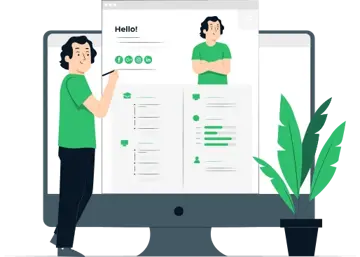
Build your Resume in 15 minutes
Create an awesome resume that meets the expectations of potential employers with our selection of professional, field-tested resume templates.

